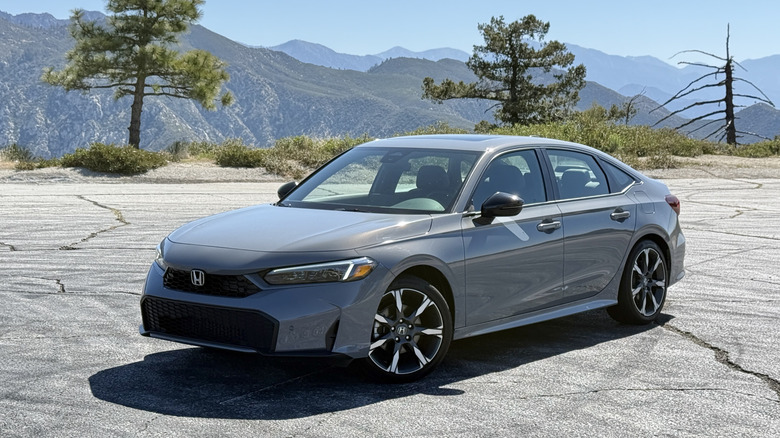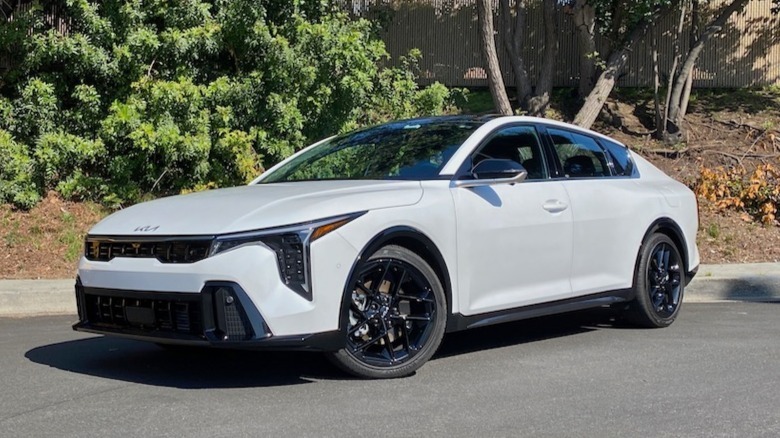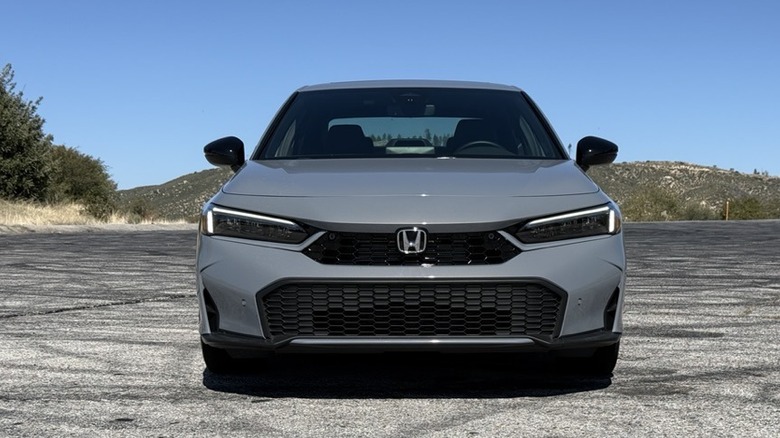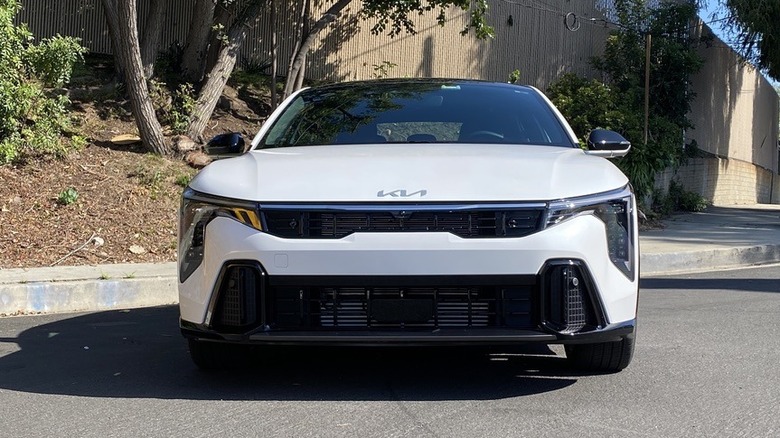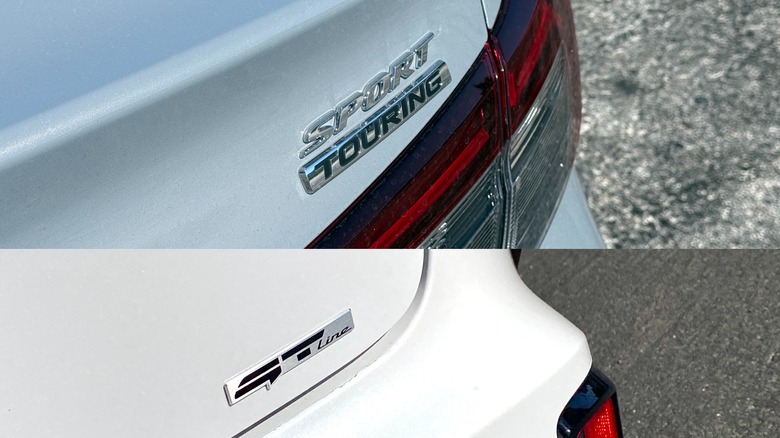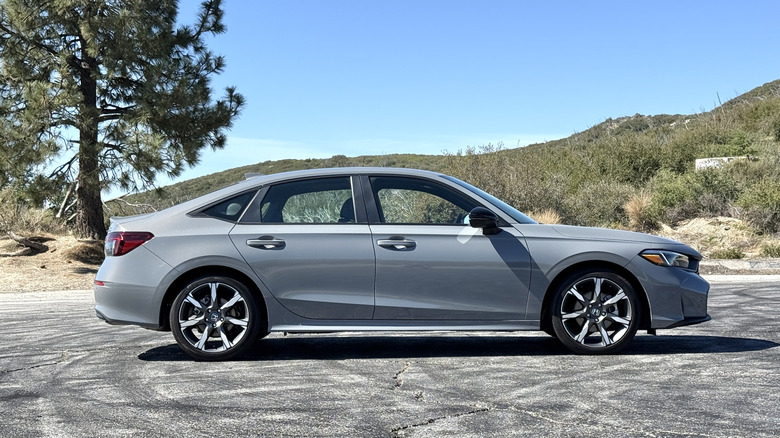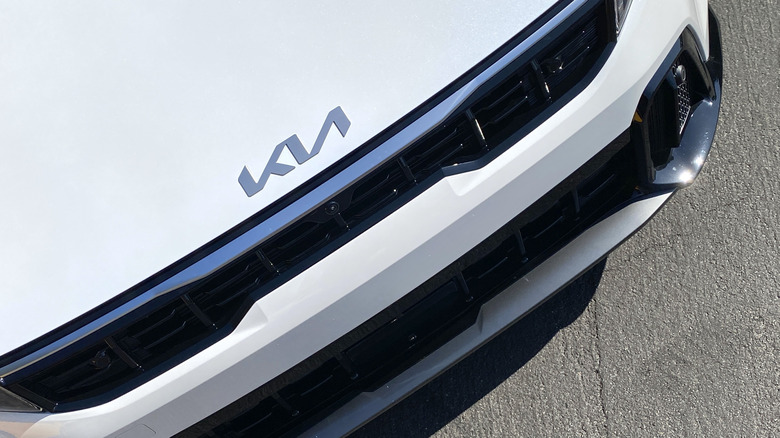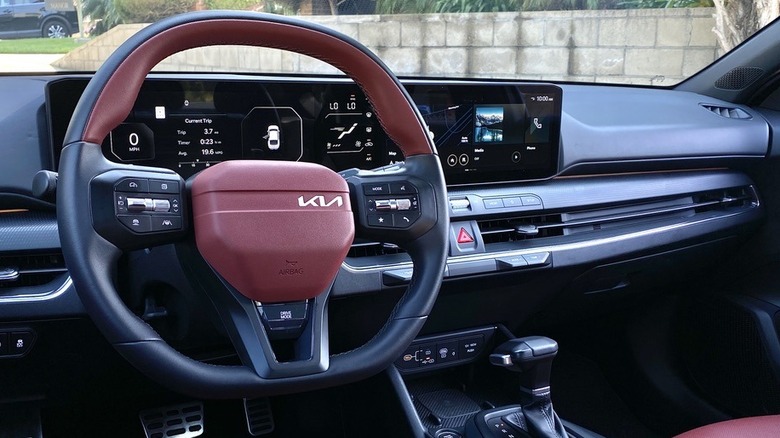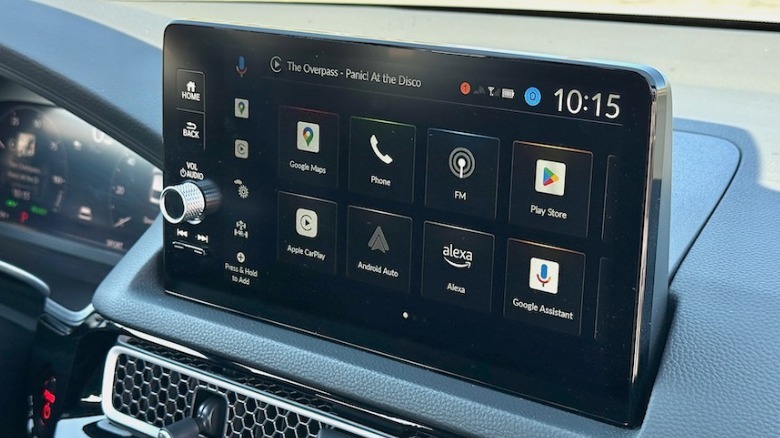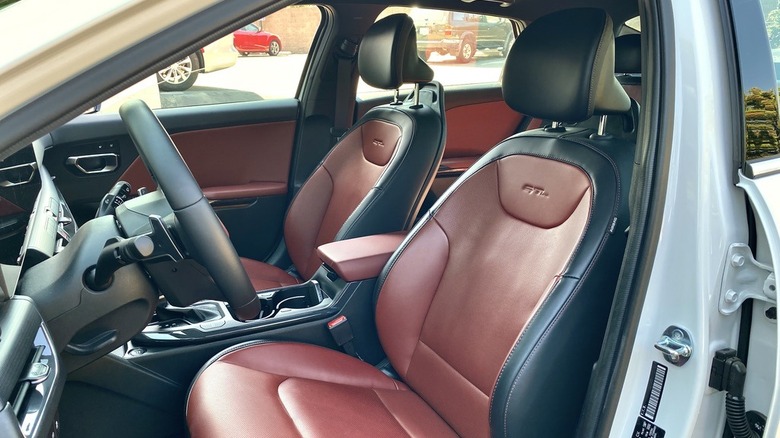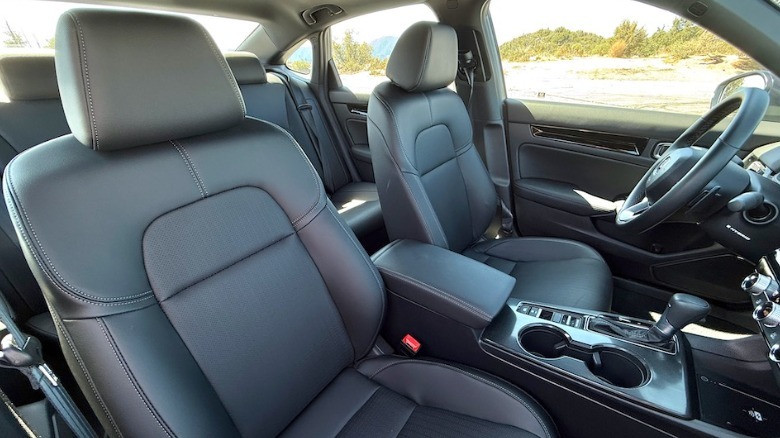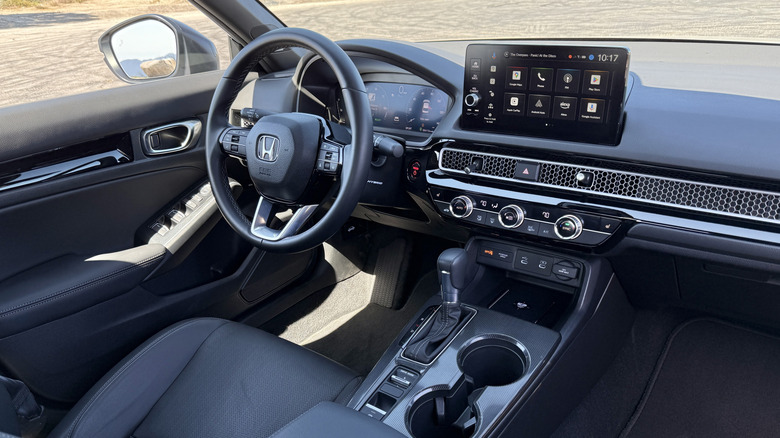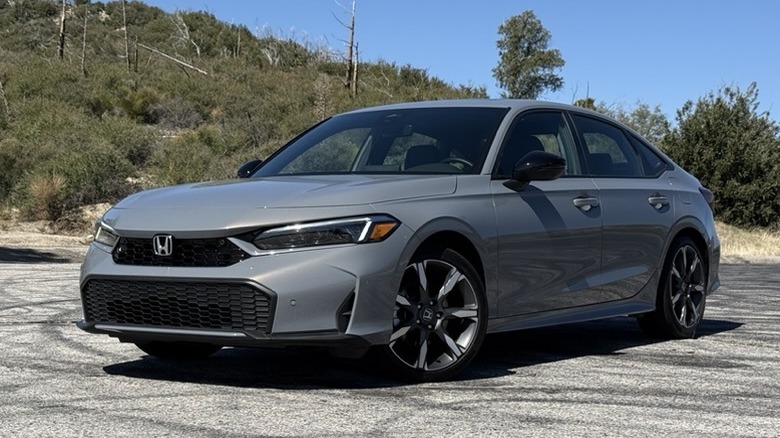Kia K4 Vs. Honda Civic: Can A Cheaper Challenger Steal The Compact Sedan Crown?
In the compact-sedan class, the Honda Civic has been a leader for decades. In our recent first drive of the 2025 Civic we were impressed by its combination of performance and practicality, not to mention fuel-efficient engine options and even a few high-performance variants to attract drivers with heavy right feet. Rivals from a number of automakers offer similar virtues, but the Civic is often the standard by which they're judged. Enter the newest challenger: the new 2025 Kia K4.
Kia's compact sedan, the Forte, was discontinued last year and replaced by the all-new K4. It's a different name, but the same recipe. In our recent review of the 2025 K4, we noted that it offers approachable pricing, efficient powertrain options, and it's refined enough to rise above its seemingly entry-level status in the compact sedan class. In other words, the Kia K4 is a much stronger rival for the Civic than the dearly departed Forte.
How do the two stack up against each other? I've not only run through the specs and stats, but factored in my driving impressions after a week behind the wheel of each of these compact sedans. My time with the Civic and the K4 included city driving, curvy mountain roads, long freeway journeys, and everything in between: in short, I put some serious miles on both cars and came out with some conclusions about which one offers more appeal as a sensible sedan.
Lots of available Honda powertrains
Honda and Kia sent me the top trim versions of their compact sedans. That meant upgraded powertrains on both models, which in the Civic's case involved a hybrid showing up on my doorstep. This is a distinct advantage for the Civic when it comes to fuel economy (we'll get to that in a bit) but it also gives it some pretty impressive power numbers.
There are two available powertrains for the Civic sedan and they correspond to the trim levels. On the base LX and Sport trims you get the naturally aspirated 2.0-liter four-cylinder engine. It makes 150 horsepower and 133 lb-ft of torque. The Sport Hybrid and the top-trim Sport Touring Hybrid trims come with a 2.0-liter four-cylinder engine that's paired with Honda's two-motor hybrid system. Total output is a healthy 181 hp and 232 lb-ft of torque. If we're honest, that's a bit more than healthy: the Civic Hybrid even has a 40 lb-ft advantage over its sporty manual-transmission sibling, the Civic Si.
The Civic Hybrid's power delivery is excellent. The torque provided by the electric motors gives it a sense of urgency when you bury the throttle. From a stand still, it moves quickly off the line almost like an EV, but the 2.0-liter engine stretches its legs on the way to a healthy redline of 6,250 rpm. It doesn't feel sporty or twitchy, but truly powerful for a compact sedan.
The K4 can't quite keep up
Like the Civic, the K4 is available with multiple powertrains but in the Kia's case, there's no hybrid available. The K4 is available in five trim levels and the available engines correspond with those trim levels. The first engine is a 2.0-liter four-cylinder engine that makes 147 hp and 132 lb-ft, almost a perfect match for the base Civic powertrain. It's the standard engine on the bottom four trim levels the K4 offers, so it's likely the engine you'll see most when you go K4 shopping.
The K4's upgraded engine, instead of a hybrid, is a turbocharged 1.6-liter four-cylinder that powers the top-trim GT-Line Turbo trim. The lack of an available hybrid powertrain is a setback we've noted when reviewing the K4, but the optional turbocharged engine remains a solid upgrade. It makes 190 hp and 195 lb-ft, so it has a small horsepower advantage over the Civic Hybrid. It does, however, have a big torque deficit.
The torque missing from the K4's optional engine shows up in the overall driving experience. The K4 feels less urgent when you bury the throttle off the line and it doesn't feel as lively or engaging as the Civic Hybrid. Acceleration tests performed by Car and Driver have the Civic Hybrid reaching 60 mph in just 6.2 seconds – more than a full second faster than the GT-Line Turbo K4. If it's maximum acceleration you're looking for, the Civic is the choice for you.
Pricing (and how much you save with a hybrid)
The two trims I tested represent the most-expensive versions of the cars available, but not everyone interested in a Civic or K4 is going to shell out that much cash. So let's talk about the pricing range these sedans cover before we go much further. The standard Civic LX, for example, starts at $25,400 (including $1,150 destination fee), with the Sport rising to $27,400. Hybrid trims rise further to $30,100 with the Sport Hybrid, and $33,100 for the Sport Touring Hybrid.
The Kia K4 is significantly less expensive than the Civic, from the base trims, all the way up to the top-level GT-Line Turbo model. The standard K4 LX has an MSRP of $23,165 (including $1,175 destination fee) which is a $2,235 savings compared to the Civic. The GT-Line Turbo trim, with the optional Technology package ($2,200) is about as expensive as it gets with the K4. It has an MSRP of $31,465. That's $1,635 less than the Civic Touring Hybrid and the K4 offers widely similar equipment (more on that in a bit).
So, no matter where you land in terms of trim-level selection, the Kia will save you money up front. In the long-run though, fuel economy differences will catch up with you.
Fuel efficiency differences between the Civic and K4
The Civic Hybrid is a clear winner if you're comparing the fuel-economy numbers, especially if you're comparing the top models, but that's no shocker when it's hybrid vs. non-hybrid. According to the EPA, Sport Hybrid and Sport Touring Hybrid models will return as high as 49 mpg combined (50 city/47 highway). Those are near-Prius numbers and give the Honda big bragging rights amongst any group of frugal sedans.
In my time with the Civic, even driving enthusiastically, I still saw numbers above 30-40 mpg in the real world. The EPA estimates that the turbocharged K4 will return 29 mpg combined (26 city/36 highway). That's a much lower number, even considering the Kia's price advantage. Driving the K4 in the real world I averaged in the high-20's: respectable, but nowhere near what the Civic offers.
With base powertrains, however, it's a much fairer fight. The 2.0-liter K4 offers an impressive EPA estimate of 34 mpg combined (40 highway/30 city). It doesn't quite beat out the base Civic LX's estimate of 36 mpg combined (32 city/41 highway), but the difference is much smaller. The prices of these two cars are pretty close together though, so what's most important is how the combination of upfront price and cost to own come out in the long run.
How much does it cost to fill up?
According to the EPA, a standard K4 with the 2.0-liter engine has an estimated annual fuel cost from the EPA of $1,400 (traveling 15,000 miles a year with a 45/55 split between highway and city driving). The GT-Line Turbo cranks that number up to $1,650. With both versions of the Civic however, those numbers are much lower. The hybrid Civic, according to the EPA, will cost you $950 a year in fuel, while the 2.0-liter engine checks in at $1,300 annually.
Comparing apples to apples, or more specifically the two trims I tested, the difference in fuel cost is $950 with the Civic Touring Hybrid compared with $1,650 with the K4 GT-Line. That's a difference of $700 a year. Scroll back a bit and you'll see that the price difference between these two trims is $1,635 upfront. The Civic's fuel-economy savings, however, will pay for the increased cost of the hybrid in a little over two years (depending on how many miles you drive each year, of course). And after those first two years, the hybrid will continue to pay off in terms of fuel savings, not to mention the extra torque and quicker acceleration.
Are there any differences in equipment?
At first glance, the equipment lists for the Civic and the K4 read relatively similarly. Both sedans offer wireless smartphone connectivity and large center touchscreens. Heated front seats and dual-zone automatic climate control are both available extras. Driver aids like adaptive cruise control, lane-keep assist, and forward collision warning are standard on base versions of both the Kia and the Honda. The differences however, show up when you look a bit closer.
Wireless Apple CarPlay and Android Auto are standard on the K4, but you have to upgrade to the top-trim Civic to get smartphone compatibility via a wireless connection. Heated front seats are equipped to each sedan's top trims, but the Kia has available ventilated front seats, an option not offered on the Civic. The K4 also offers a surround-view monitor as an option on the top trim. A 360-degree camera isn't available on the Civic.
When it comes to screens, the Kia wins the size comparison outright. Every K4 comes standard with a massive 12.3-inch touchscreen while all three of the bottom trims on the Civic get a 7-inch touchscreen that seems anemic by comparison. Sure, the top Sport Touring gets a 9-inch center touchscreen, but compared to the K4's screen it's low-res and visually much less appealing. For drivers that are looking for a bit more in the way of standard features, the Kia is seriously compelling.
Passenger space and cargo are a dead heat
The K4 is larger than the old Forte, measuring about 3 inches longer from nose to tail, which means it's now longer than the Civic: the K4 is 185.4 inches long, the Civic is 184.4 inches. Their wheelbases are within an inch of each other, their height is almost exactly the same (0.2 inches difference), and K4 is less than 2 inches wider than the Civic.
The race for more space is just as even on the inside, where differences in legroom, headroom, and shoulder room are almost all within half an inch of each other. Both sedans are plenty spacious enough for four adults, with enough room to squeeze a fifth person in the middle seat for short journeys. They might be considered "compact" sedans, but both the Civic and K4 offer impressive interior space.
This neck-and-neck competition continues when it comes to bringing all your gear along too. The K4 offers 14.6 cubic feet of cargo storage in the trunk. The Civic edges it out ever-so-slightly with 14.8 cubic feet of storage. Essentially, either sedan should have enough room for a few suitcases on your next road trip or plenty of space for your next shopping trip to the local big-box store. The only real advantage here that the Civic has is its availability as a hatchback, where cargo space increases considerably to 24.5 cubic feet.
Differences on the road
Both the K4 and the Civic proved to be comfortable commuters. The Civic has an edge when it comes to driving dynamics thanks to better steering and more responsive handling, which is especially important if you're like me and you spend your spare Saturdays connecting corners in the canyons. The Civic's interior is only available in black or gray color schemes, so the Kia feels a bit more vibrant.
The Kia and the Honda are both relatively quiet on the inside, but with one small exception: driving the Civic, there was an audible hum from the tires at most highway speeds. Thankfully, add a little bit of music and the hum was imperceptible. In both the Civic and the K4, the driver's seat was supportive enough for long-distance driving, but the shape of the Civic's seat (i.e. bigger bolsters) seemed better-suited to keep me in place.
Another place where the Civic inches ahead is in stereo quality. Base versions of the Civic get a 4-speaker stereo, and mid-level trims get an 8-speaker stereo with a bit more power, but the really impressive stereo is only available on the Sport Touring. It's a Bose system with 12 speakers (including a subwoofer) and it provides impressive volume and clarity. The K4's 8-speaker Harman/Kardon stereo is decent, but given the choice I'd opt for the Civic's stereo.
The Verdict: Honda Civic Wins
Given the choice between the 2025 Civic Touring Hybrid and the 2025 K4 GT-Line Turbo, I'd go with the Civic. The K4 offers a lot of value on lower trims and a long list of equipment on upper trims, including all the driver aids and creature comforts you'd expect. If you're looking for a lot of equipment for the money, an upscale interior, and plenty of room for passengers and cargo, the Kia won't disappoint. And, while it might be slightly unfair to compare the hybrid-powered Civic to the non-hybrid K4, I think the Kia's strength in this head-to-head comparison is a testament to the K4's overall appeal. Even with a serious fuel economy disadvantage, it's still worth a closer look.
The Civic, however, is a more complete package. Fuel economy numbers with the hybrid powertrain are undeniable and I thoroughly enjoyed driving the Civic on winding back roads – a virtue I would've previously assigned to high-performance versions of the Civic like the Si or the Type R. The Civic trails in a few categories like standard and available equipment, but it's only missing a few items and long-term math has a role to play here too. Bargain shoppers may be drawn to the K4 upfront, but the Civic is likely the more sensible car to drive every day.
